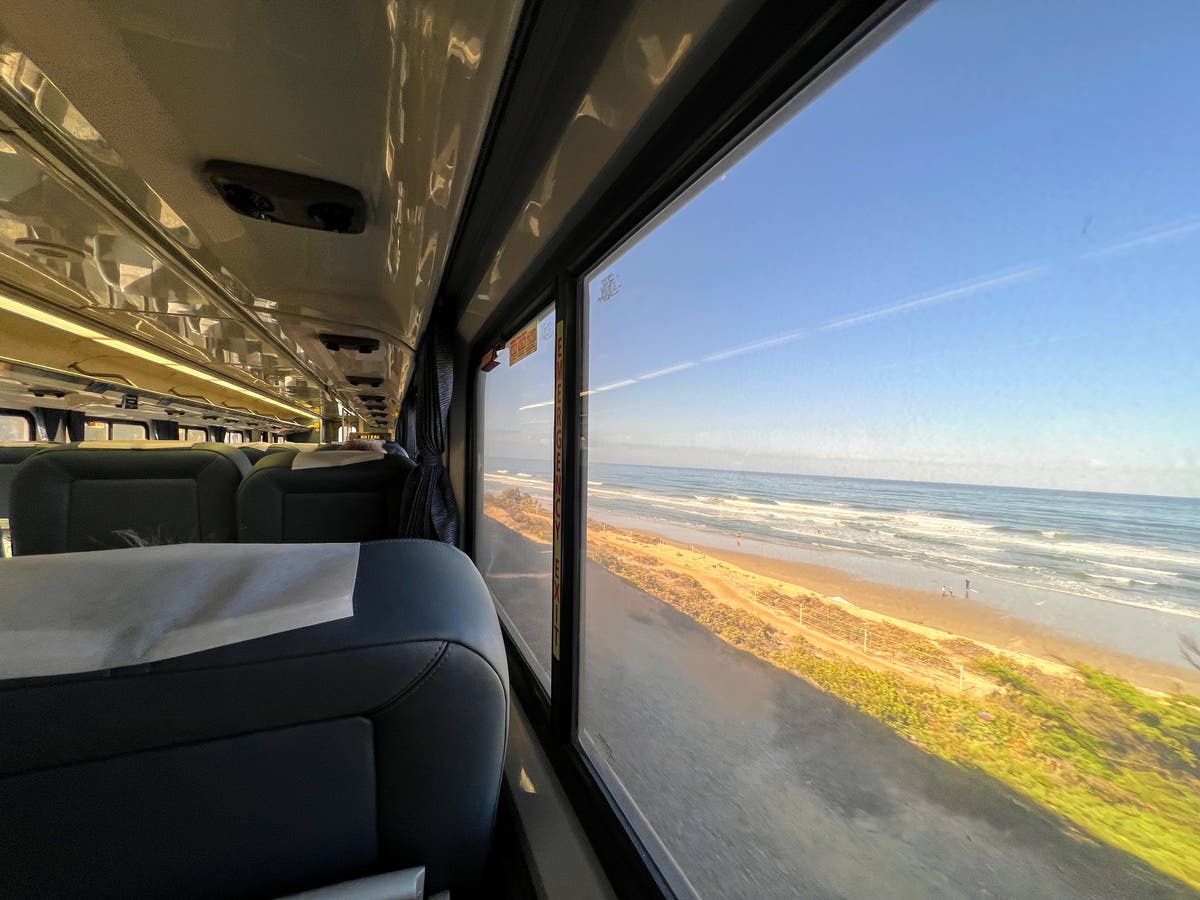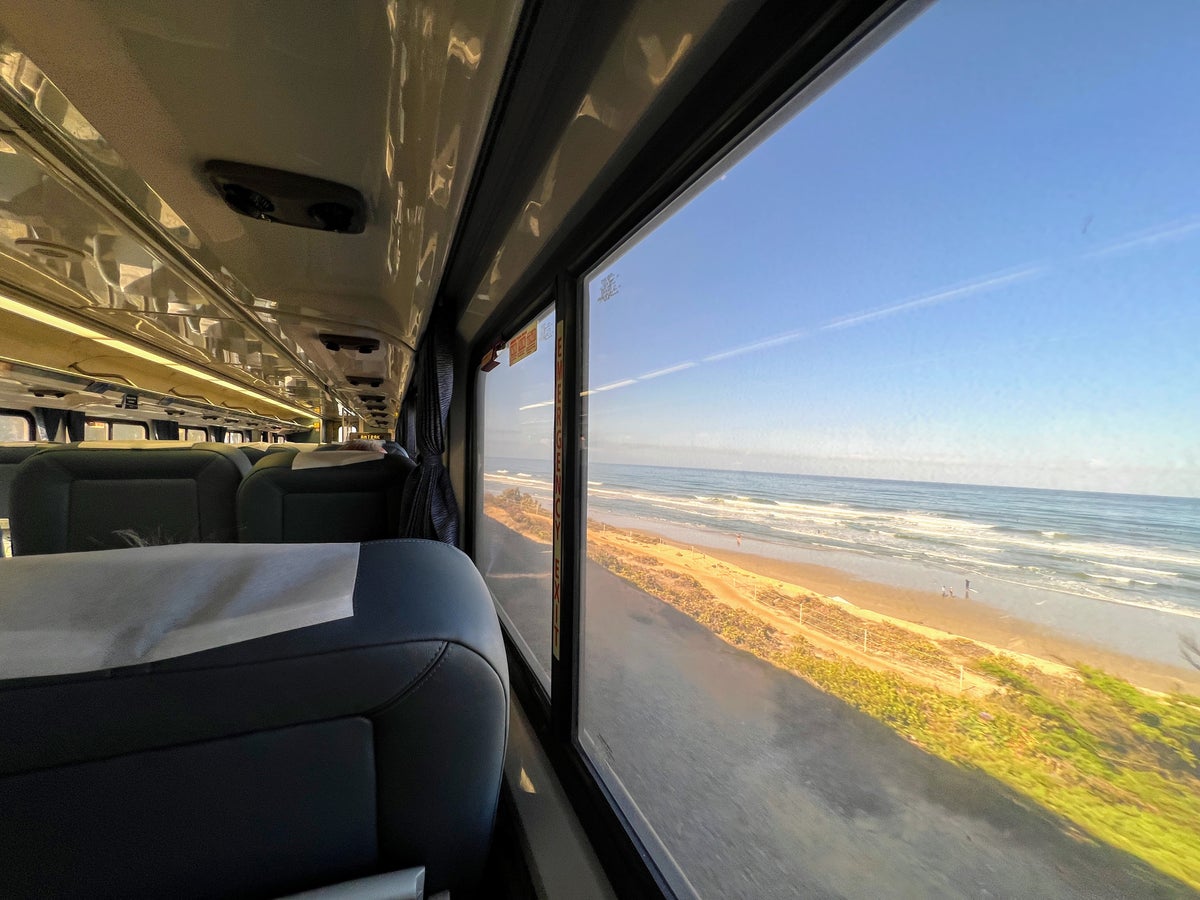A recent family event took me to my dad’s homeland of southern California. I enjoy returning to my country of birth except for one pesky thing: driving. As a Londoner of 11 years, I am spoiled by British public transport (however flawed some may think it). This time, as I reluctantly checked car hire options and choked at the price of petrol, a wild idea snuck into my brain.
Might it be possible to navigate California entirely by public transport? On a video call, I told my family I might not rent a car and they scoffed. California is, after all, the land of the road trip. The first-ever motorway – the Pasadena Freeway – opened in LA in 1940 and, for many, the defining image of California is of driving down a palm-lined Hollywood avenue in a red convertible.
But the madness of this plan was too much to pass up. I would prove a car-free southern California trip was possible, trundling along beachside railway lines rather than sitting stuck in traffic on concrete freeways. To add to the challenge, I vowed to make the trip as sustainable as possible by staying in hotels with strict environmental credentials and supporting community-led businesses with my picks of where to eat, drink and sightsee. What could go wrong?
Pacific Surfliner boarding in San Luis Obispo
(Megan Eaves)
Public transport
The Pacific Surfliner is an Amtrak train service that travels along a 351-mile route hugging the southern California coast. It traverses wine country, passes Disneyland and Hollywood, and travels nearly all the way to the US-Mexico border. It also connects with the rest of the Amtrak network, going east to Chicago or north to Seattle.
Los Angeles and San Diego both have public transport networks with subways, trams, buses and light rail. Apps with integrated, digital top-up cards make ticketing a breeze. You can get from Los Angeles International Airport into several parts of LA, including Amtrak’s Union Station downtown, using the FlyAway airport bus.
San Diego’s trolley system makes getting around simple
(Megan Eaves)
German coach company Flixbus is also expanding its SoCal routes, with an eco-friendly fleet of affordable buses from LA to destinations around the region, including San Luis Obispo, where my journey began.
San Luis Obispo
Around 200 miles north of LA, the small city of San Luis Obispo (often shortened to SLO) sits at the heart of its own wine region, which was the setting for the 2005 film Sideways. Founded by Spanish colonists in the 1700s, San Luis Obispo’s old town still centres on its 1772 mission church and the San Luis Obispo Creek. A grid of walkable, leafy streets is home to locally owned boutiques, cafes, breweries and wine tasting rooms. Surrounding the city, the Santa Lucia Mountains have hikes for every level.
Newly opened in 2022, Region is a tasting room specialising in wines from the area. Operating as a collective of 26 small producers, Region features a pour-it-yourself preservation system designed to connect drinkers directly to hard-to-find wineries – the perfect option for experiencing California wine country without a car. They also donate a portion of sales to international organisation 1% For the Planet for environmental causes.
Wine sampling at Region in SLO
(Megan Eaves)
For dinner, Novo is a chic, locally owned restaurant set inside a former cigar factory with a fairy-light-draped garden beside the river. Chefs source all of the ingredients from local producers – the shrimp spring rolls and diver scallops are divine.
Check out SLO Car Free for tips and discounts if you’re visiting without a vehicle.
Getting around
San Luis Obispo is easily walkable; city buses connect the train/coach station with downtown.
Where to stay
Hotel San Luis Obispo is a boutique hotel with a sustainable remit, including eliminating plastic waste and providing filtered water stations throughout. Their rooftop bar, which serves local wines, is perfect for a mountain-view sundowner.
Santa Barbara
Halfway between SLO and Los Angeles, coastal Santa Barbara is one of the most eco-friendly cities in the US. Earth Day was founded in 1970 following a massive oil spill off the Santa Barbara coast, leading to the creation of the US Environmental Protection Agency (EPA) and the passage of the Clean Air, Clean Water and Endangered Species Acts. Today, the city has one of the most robust plans for carbon neutrality in the US, including electrifying transportation, encouraging active transport, decarbonising the electrical grid and construction sector, and sourcing drinking water from a seawater desalination plant.
Santa Barbara is known for its tall palms
(Megan Eaves)
You learn about all of this while sipping and tasting your way through some of Santa Barbara’s local producers on an eco-tasting tour with Totally Cali Tours. This four-hour walk led by passionate local environmentalist Melissa Hopf takes you to wine tasting rooms, sustainable breweries and even a local olive oil producer. To dive deeper into coastal environmental issues and restoration of marine ecology, visit the Museum of Natural History Sea Center on the pier.
Getting around
Santa Barbara’s old town and beach are very walkable, and the city has a network of buses, e-bikes and scooters.
Where to stay
The beautiful Blue Sands Inn is a traditional beach motel turned boutique inn that supports local artisans and green environmental practices. It’s two minutes from the beach on foot.
Los Angeles
Visiting LA without a car requires careful planning and a few compromises, but is entirely doable. Staying by the beach in Santa Monica is one of the nicest options, with plenty of fresh, local food, cute cafes, shopping and, of course, the beach and beloved Santa Monica Pier with its amusements, bars and antique merry-go-round. To eat, the Albright is a family-owned, sustainable seafood shack that has been in business on the pier since 1977.
Santa Monica Pier and its amusements
(Megan Eaves)
Getting around
The LA subway covers many of the significant sights like Hollywood, Santa Monica, downtown and Universal Studios, while buses connect to the rest. Though I avoided it, ride-sharing is common in LA and can get you somewhere in a pinch.
Where to stay
The Shore Hotel is located on the waterfront in Santa Monica and ticks numerous sustainability boxes, while ultra-hip 1 Hotel West Hollywood has been called one of the most eco-friendly hotels in the world. It’s located right on Sunset Boulevard, built entirely of reclaimed materials like salvaged woods and recycled ocean plastics, and has a rooftop pool with views across LA.
Malibu
An alternative view of the famous Pacific Coast Highway can be found by detouring from the train to the coastal town of Malibu. Though best known as a haven for celebrity mansions, the town itself is relaxed and beachy with a pretty pier, swimming and surfing. For food, sample the fresh yuzu butternut squash linguine or cauliflower crust pizza at farm-to-table Malibu Farm Cafe on the pier.
The rooftop restaurant at the Surfrider Hotel in Malibu
(Megan Eaves)
Getting around
LA bus 534 travels up the Pacific Coast Highway, connecting Malibu to Santa Monica and the LA subway. Once you’re here, it’s walking, surfing or swimming.
Where to stay
The Surfrider Hotel is a classy, airy boutique motel with locally curated textured furnishings and textiles that give it the warm feel of a beach house. A sunset dinner at the guest-only rooftop restaurant is a must.
Oceanside
For decades, prosaically named Oceanside – around 80 miles south of LA – was known for two things: soldiers and surfers. Primarily catering to marines from nearby Camp Pendleton, Oceanside had a reputation for seedy dive bars, surf shacks and not much else. In recent years, the city has been reinvented thanks to the opening of two eco-friendly resort hotels on the waterfront, which were followed swiftly by new cafes, restaurants and breweries.
‘Nose-to-tail’ zero-waste sushi at Wrench & Rodent in Oceanside
(Megan Eaves)
Oceanside was one of California’s original surfing hotspots in the 1950s, a history exhibited in the California Surf Museum here. You can ride the legendary waves by signing up for a lesson with North County Surf Academy’s third-generation pro surfer, Duran Barr. For dinner, don’t miss Wrench & Rodent – a ‘nose-to-tail’ sushi concept restaurant from British chef Davin Waite, whose ‘waste not’ philosophy means utilising every part of the animal or plant for dishes like Fish Skin Chips and Kentucky Fried Tuna Heads.
Getting around
Oceanside’s main grid, including the train station and beach, is walkable. To reach Wrench & Rodent, catch a city bus from Oceanside Transportation Center.
Where to stay
Twin resorts Mission Pacific and The Seabird, both of which opened in 2021, can take a big dollop of credit for Oceanside’s recent transformation into a tourist hotspot. Both boast sustainability credentials and huge, luxe rooms with ocean views.
San Diego
Sunny San Diego is the southernmost city in California and this tour’s final stop. The city has a rich Hispanic heritage thanks to its proximity to the Mexican border, concentrated in the Barrio Logan neighbourhood – an area where the Hispanic and Chicano communities were displaced by the building of a freeway bridge in the late 1960s. In Chicano Park, dozens of huge murals depict the community’s struggle for equality. Visit on a Saturday for ‘Walk the Block’, a community initiative created to help small businesses struggling during the pandemic. Shop owners and local vendors set up outdoor booths along Logan Avenue – sample street food, take home an upcycled souvenir from Mexican-American designer Claudia Rodríguez-Biezunski’s boutique, Sew Loka, and don’t miss Mujeres Brew House, a female Latinx-owned brewpub.
Chicano Park in San Diego is filled with murals about Hispanic and Chicano struggles for equality
(Megan Eaves)
The best part of San Diego to enjoy on foot is sprawling Balboa Park, home to a handful of museums, including the Mingei, an international folk-art museum that promotes cultural understanding and celebrates the use of unusual and upcycled materials.
You can’t go wrong for sustainable, progressive food and drink in San Diego. Opt for dinner at Herb & Wood for Mediterranean dishes prepared with California sustainability, or Bib Gourmand restaurant Juniper & Ivy, with its push for imaginatively rendered, seasonal ingredients. San Diego is also a centre of American craft beer, so there’s a lot of choice, but from a sustainability perspective, Pure Project Brewing is a top choice. It’s a member of 1% for the Planet, is carbon-neutral, zero-waste certified and puts community support at the heart of its operations.
Getting around
San Diego’s public transport network consists of street trams (called trolleys), light rail and buses that cover the entire county as far north as Oceanside.
Where to stay
The Hotel Solamar’s warm, Spanish architecture and convenient downtown location are matched by a strong sustainability policy. Or the Hotel Indigo – although a chain – is San Diego’s first Leadership in Energy and Environmental Design (LEED)-certified hotel.
Bonus: Mexico day trip
San Diego’s proximity to the US–Mexico border makes an international day trip within reach. The San Diego trolley delivers you to passport control, where you can walk across the border into Mexican counterpart Tijuana. Rummage through the main market, Mercado Hidalgo, for everything from spices to piñatas and Mexican sweets, and have the eponymous salad at Caesar’s, where it was invented.
Alternately, sign up for a day tour with San Diego Baja Tours, where madcap guide Tommy Cox – a Baja expert – will lead you on a rollicking trip (albeit in a vehicle) down the coast to the relaxed city of Ensenada, with a detour through the up-and-coming wine region of Valle de Guadalupe to sample boutique wines made by small, family producers.








More Stories
Everything you need to know about July and August rail industrial action
‘It’s cancerous’: How seaside towns fight back against second home owners
EasyJet flight diverted after passenger medical emergency on board